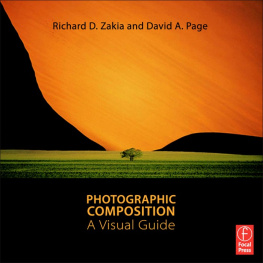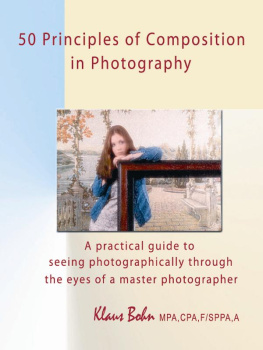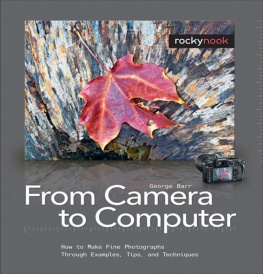Capture the Magic
Capture the Magic
Train Your Eye, Improve Your
Photographic Composition
Jack Dykinga
Editor: Joan Dixon
Copyeditor: Theano Nikitas
Layout: Petra Strauch
Cover Design: Helmut Kraus, www.exclam.de
Printer: Tara TPS, Ltd. through Four Colour Print Group
Printed in Korea
ISBN: 978-1-937538-35-4
1st Edition 2014
2014 Jack Dykinga
Rocky Nook, Inc.
802 E. Cota Street, 3rd Floor
Santa Barbara, CA 93103
www.rockynook.com
Library of Congress Cataloging-in-Publication Data
Dykinga, Jack W.
Capture the magic : train your eye, improve your photographic composition / by Jack Dykinga. -- 1st edition.
pages cm
ISBN 978-1-937538-35-4 (softcover : alk. paper)
1. Composition (Photography) I. Title.
TR179.D96 2013
770.1-dc23
2013023613
Distributed by OReilly Media
1005 Gravenstein Highway North
Sebastopol, CA 95472
All rights reserved. No part of the material protected by this copyright notice may be reproduced or utilized in any form, electronic or mechanical, including photocopying, recording, or by any information storage and retrieval system, without written permission of the publisher.
Many of the designations in this book used by manufacturers and sellers to distinguish their products are claimed as trademarks of their respective companies. Where those designations appear in this book, and Rocky Nook was aware of a trademark claim, the designations have been printed in caps or initial caps. All product names and services identified throughout this book are used in editorial fashion only and for the benefit of such companies with no intention of infringement of the trademark. They are not intended to convey endorsement or other affiliation with this book.
While reasonable care has been exercised in the preparation of this book, the publisher and author assumes no responsibility for errors or omissions, or for damages resulting from the use of the information contained herein or from the use of the discs or programs that may accompany it.
This book is printed on acid-free paper.
For Nicholas
May his world be filled with beauty and magic
Decisions
What is it that piques our interest? Why do we stop, pull out the camera, and decide to photograph?
In order to answer these questions, we need to look at photography as a form of communication. Its a marvelous languageuniversal, powerful, and one that crosses linguistic borders. We see something that we find interesting and we simply want to share it.
My journalistic background taught me to go a step further, by emphasizing that images require content that both affects and enlightens the viewer. Since much of my work is related to environmental causes, I want my work to take the viewer to places less traveled and even less seen.
The problem is: not everything we wish to photograph is visually pleasing. In order to communicate effectively, we must learn to compose and craft our images. And we need good composition.
Why do some images cause us to linger for a more contemplative study? Often its not apparent, but in successful images the photographer has organized the visual elements in the image to direct our focus and our emotional reaction. Through the careful use of composition, photographers share their personal visions and create pathways for a shared vision.
We all love to use the camera to record unusual events. Imagine driving through a parched landscape with only the strongest plants surviving. Then imagine my reaction driving through the same desert after an unusually wet spring when the harsh Sonoran Desert poured forth color. My pulse raced and I inhaled the scent of spring. My overpowering urge to share this scene demanded that I photograph it.
There seem to be many factors that draw us to capture particular images; certain primal human biases that we collectively respond to: things like color, fire, water, movement, chaos, or perfect order. Photographers who recognize and exploit this commonality increase their potential to reach viewers with their images.
Images are ubiquitous and we can learn and profit from those who have gone before us. The giants of photography have laid down paths to follow, and they have provided stirring examples of their visions and approaches to photography. During the learning process we all borrow styles and techniques as we expand our own capabilities. However, meaningful photography is also deeply personal. It must reflect our personal visions. How we respond to visual stimuli is where it all begins.
Once Ive decided to make a photograph, my first goal is to get to know the subject or area. I make visual inventories of what I observe and I search for potential images that help create a narrative that will describe my subject. I make basic decisions concerning each potential image, a process that I refer to as honoring the subject. At the most basic level, if its a tall mountain I will think vertically, or with the dry saltpans in Death Valley, Im likely to think horizontally or, as in this image, even panoramic.
Problems can arise quickly when were confronted with a new and strange landscape. Its easy for visual overload to occur. Thats perfectly normal. When Im on an assignment and the clock is ticking down to a deadline, Ive been known to panic about needing to be creative on demand. I believe this happens to us all.
But how do I begin? My technique is quite simple. I start small. While making my visual inventory, telling details within the grand landscape often grab my attention. For me, they are the most important. They provide the flavor of a place. I also look for designs, colors, or biological significance. I take my time, rejecting many situations until the perfect combination of light, form, and moment come together. A photographer is defined as much by what he or she decides not to photograph as by what is photographed.
The key to successful photography is taking time to really see. It may sound simple, but this is the hardest thing we dotraining the eye to see nuances in colors, compositions, and imperfections.
I can easily find compositions from a speeding car; however, when I actually walk the land and carefully observe, the imagined images evaporate.
My friend, Jay Dusard, likes to say: Were imposing a rectangle on a scene. We control whats in and whats out of the rectangle. Its our personal canvas on which to create our masterpiece. Theres always one thing that makes us decide that a scene is worthy of a photograph. We decide the point of interest and how best to emphasize it.
An example of this was when I was in southern Utah, deep in the chaotic canyon complex on the Escalante River drainage when an amazing scene of sunflowers emerging from the pink sand lay before me. I loved the desert-varnished cliffs rising above the dunes. I loved the struggle for life taking place in the shifting sands. In fact, I loved everything. So I composed a scene that reflected that vision, as seen in the image on this page.
But I knew at once the real reason I stopped was that I was drawn by the struggle for survival of a half-buried sunflower. By showing everything in the scene, I was giving equal weight to all the elements. If I couldnt decide what was important, how could I expect the viewer to know what moved me to photograph the scene?
Next page







